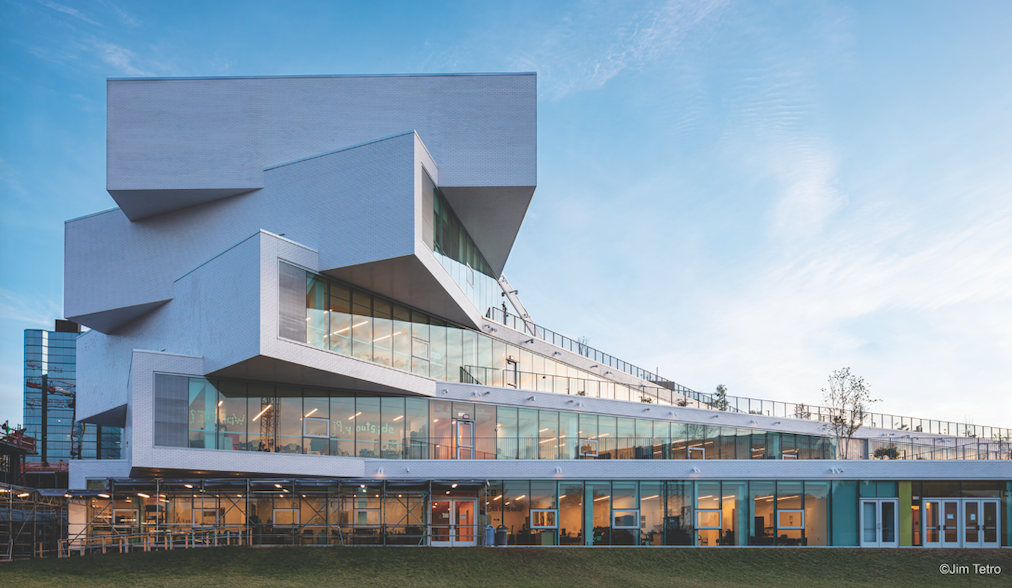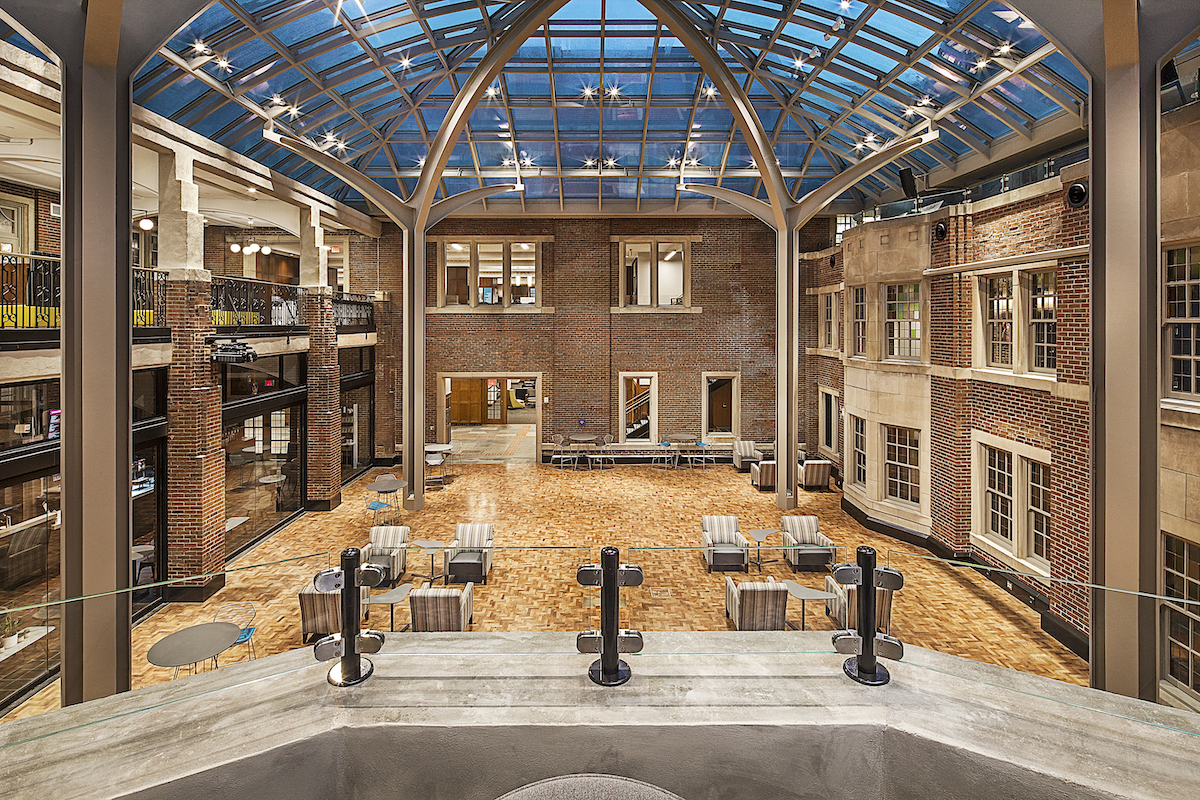Contractors continued to explore ways to expand their businesses, enhance collaboration, and boost productivity.
Many pros found answers in their embrace of technology. Skanska’s project planning team developed Skanska Metriks, which provides benchmarking data to help evaluate the parameters of a building’s systems relative to similar projects. PCL Construction partnered with Nureva to develop and launch Nureva Visual Planner, which enables teams to effectively visualize, coordinate, and plan project activities in person or remotely. Ryan Companies is using AI, specifically computer vision, to monitor projects by placing multiple cameras around jobsites to “see” what is going on.
At the start of 2020, Swinerton acquired two Boston Dynamics SPOT quadruped robots to use as tools for automating field data capture with attached lidar scanners, 360 cameras, and other payloads. Clancy & Theys implemented drone technology for marketing, preconstruction, and construction. Its latest drone approach captured the construction site prior to major concrete pours.
Throughout 2019, Arc Building Partners worked to integrate a management operating system (MOS) that allows the firm to incorporate tools, meetings, and behaviors used to manage teams and processes. Walbridge designed and built out virtual meeting rooms with large, collaborative technology walls to improve communication between program offices.
Contractors are more receptive than ever to ways that help get projects done faster. Level 10 is using SpeedCore on its new 200 Park Ave. project in downtown Sunnyvale, Calif., scheduled for completion in 2023. This is the first project in that state to use the new hybrid core system, a concrete-filled composite shear wall core that takes 40% less time to erect than a comparable cast-in-place reinforced concrete core.
Modular design and construction are also saving contractors time and money. Lendlease has been rolling out Wellness Pods, a patent-pending solution that the firm claims are the first fully functioning modular restrooms introduced to the industry. The pods are engineered to be hoisted vertically, so they can be deployed on high-rise projects.
M.C. Dean invested $25.1 million to expand its ModularMEP Manufacturing and Systems Integration Facility, which serves as the home for the firm’s product line of large-scale, fully-integrated, modularized power, electronic security, and telecom systems and rooms that are designed, engineered, integrated, tested, and pre-commissioned before being transported to project sites across the U.S.
Factory performed prefabrication in general is becoming integral to contractors’ estimating and delivery efficiencies. Balfour Beatty, in a joint venture with LF Driscoll, is part of an integrated project delivery (IPD) team building The Pavilion, a flagship hospital for Penn Medicine in Philadelphia scheduled to open next year. By standardizing the building’s structural floor plate and interior design early in the project, the team was able to prefabricate mechanical racks, bathroom pods, and zone valve boxes in a 60,000-sf offsite warehouse. CG Schmidt launched its own prefab center, housed within its existing yard operations. On a recent freestanding clinic project, prefabrication of the wood framing allowed for all walls and framework to be erected in two days.
While nonresidential construction currently consumes a sliver of mass timber produced, the use of these engineered wood components is growing for many different projects. In June 2019, HITT Contracting opened Co|Lab, an R&D facility in Falls Church, Va., the first commercial mass timber structure in that state. DPR Construction used cross-laminated timber panels in the construction and renovation of the firm’s new office space in Sacramento, Calif. And Nabholz Corporation finished construction of the University of Arkansas’ Adohi Residence Hall, the country’s first large-scale mass timber residential hall.
U.S. contractors become leaner machines
In 2019, nonresidential construction spending rose 2.8% to $782 billion, according to Census Bureau estimates. During that period, Summit Contracting Group broke ground on a dozen projects for repeat customers, including one whose contract value is the largest in the firm’s history: Novel Midtown, a mixed-use development in Tampa, Fla., showcasing 390 units in three buildings with 341,055 sf of livable space and 206,000 sf of retail.
Lean construction practices that minimize waste are catching on. More than 141 people enrolled in Gilbane’s Lean Practitioner program, a blended learning solution where the knowledge and experience of the participants work together to create a depth of expertise upon which they can build on. Sixty-two participants completed the program to become certified Gilbane Lean Practitioners.
To encourage Lean practices, Robins & Morton held their inaugural Building Forward Connect event in March 2019. The two-day event brought together more than 600 attendees.
ALSO SEE: 2020 GIANTS 400 Contractor Rankings

• Top 135 Contractors: Turner, Whiting-Turner, and STO Building Group head the rankings of the nation's largest general contractors, CM at risk firms, and design-builders for 2020. See the complete rankings.
• Top 85 Construction Management + Project Management Firms: Jacobs, CBRE, VCC, and JLL top the rankings of the nation's largest construction management (as agent) and program/project management firms for 2020. See the complete rankings.
For the full Giants 400 rankings and bonus categories, visit: BDCnetwork.com/Giants2020.
Pictured: Arlington (Va.) Public Schools Heights Building. Photo: Jim Tetro, courtesy Gilbane
VJS Construction Services practices Lean Schedule Management, which enables its team to focus on efficient workflow, eliminating waste and over burdening of resources by looking at the project as a whole versus as a sum of its components. On VJS’s recently completed Fairway Knoll project in Germantown, Wis., the Phase-1 turnover was completed five weeks earlier than scheduled.
On the M&A front, STO Building Group added two companies: BCCI Construction Company and Layton Construction. In September 2019, Cortland Build acquired Pure Multi-Family, a Canada-based REIT that owned and operated communities in Dallas-Fort Worth, Houston, Austin, San Antonio, and Phoenix.
To support its burgeoning client base in the U.K., Cumming added construction consulting teams in London, Edinburgh, Manchester, and Stoke-on-Trent. Burns & McDonnell, which hired nearly 1,400 people globally last year, launched its first new brand in the firm’s history with 1898 & Co., a future-focused consulting and technology solutions arm. And McCarthy Building Companies expanded its expertise with the launch of McCarthy Mapping, a specialized service that helps owners and project teams accurately locate buried utility lines and other underground hazards before they potentially impact construction projects.
Related Stories
| Jan 10, 2011
Michael J. Alter, president of The Alter Group: ‘There’s a significant pent-up demand for projects’
Michael J. Alter, president of The Alter Group, a national corporate real estate development firm headquartered in Skokie, Ill., on the growth of urban centers, project financing, and what clients are saying about sustainability.
| Jan 7, 2011
BIM on Target
By using BIM for the design of its new San Clemente, Calif., store, big-box retailer Target has been able to model the entire structural steel package, including joists, in 3D, chopping the timeline for shop drawings from as much as 10 weeks down to an ‘unheard of’ three-and-a-half weeks.
| Jan 7, 2011
How Building Teams Choose Roofing Systems
A roofing survey emailed to a representative sample of BD+C’s subscriber list revealed such key findings as: Respondents named metal (56%) and EPDM (50%) as the roofing systems they (or their firms) employed most in projects. Also, new construction and retrofits were fairly evenly split among respondents’ roofing-related projects over the last couple of years.
| Jan 7, 2011
Total construction to rise 5.1% in 2011
Total U.S. construction spending will increase 5.1% in 2011. The gain from the end of 2010 to the end of 2011 will be 10%. The biggest annual gain in 2011 will be 10% for new residential construction, far above the 2-3% gains in all other construction sectors.
| Jan 7, 2011
Mixed-Use on Steroids
Mixed-use development has been one of the few bright spots in real estate in the last few years. Successful mixed-use projects are almost always located in dense urban or suburban areas, usually close to public transportation. It’s a sign of the times that the residential component tends to be rental rather than for-sale.
| Jan 4, 2011
Product of the Week: Zinc cladding helps border crossing blend in with surroundings
Zinc panels provide natural-looking, durable cladding for an administrative building and toll canopies at the newly expanded Queenstown Plaza U.S.-Canada border crossing at the Niagara Gorge. Toronto’s Moriyama & Teshima Architects chose the zinc alloy panels for their ability to blend with the structures’ scenic surroundings, as well as for their low maintenance and sustainable qualities. The structures incorporate 14,000 sf of Rheinzink’s branded Angled Standing Seam and Reveal Panels in graphite gray.
| Jan 4, 2011
6 green building trends to watch in 2011
According to a report by New York-based JWT Intelligence, there are six key green building trends to watch in 2011, including: 3D printing, biomimicry, and more transparent and accurate green claims.
| Jan 4, 2011
LEED 2012: 10 changes you should know about
The USGBC is beginning its review and planning for the next version of LEED—LEED 2012. The draft version of LEED 2012 is currently in the first of at least two public comment periods, and it’s important to take a look at proposed changes to see the direction USGBC is taking, the plans they have for LEED, and—most importantly—how they affect you.
| Jan 4, 2011
California buildings: now even more efficient
New buildings in California must now be more sustainable under the state’s Green Building Standards Code, which took effect with the new year. CALGreen, the first statewide green building code in the country, requires new buildings to be more energy efficient, use less water, and emit fewer pollutants, among many other requirements. And they have the potential to affect LEED ratings.













